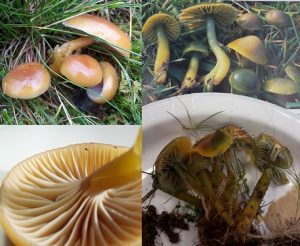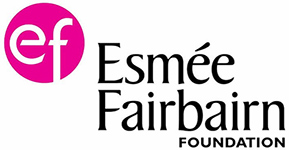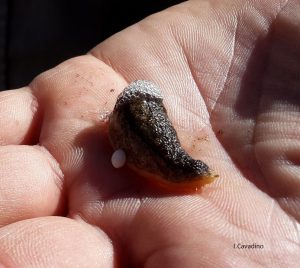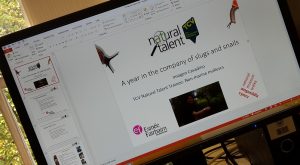
Hello again!
Incredibly rare slug behaviour
At the end of last month the knowledgeable Mark Telfer popped into Wales for a visit. He was keen to see a site for the species Testacella maugei (Atlantic Shelled Slug or Dead Man’s Finger) – which happens to be St Fagans National History Museum, part of the National Museum Wales group. Ben casually offered me the option to come along, and I jumped at the chance. A day in the field with three fellow slug enthusiasts? No chance I was turning that down! And it was definitely worth it.
Upon arriving on site, we met one of the head gardeners who was happy for us to wander in the behind the scenes garden area. Here we had a fabulous time looking under plant pots, lifting paving slabs and picking through parts of the impressive compost heap.
Ben gave me a tip off to where they had found T.maugei before, and we immediately struck gold finding two resting underneath a plant pot. We immediately headed back to the others, slugs in hand to show the others. Which is when two incredibly odd things happened…
Slug sick
Firstly the slug in my hand started regurgitating its dinner – something non of us had witnessed or heard of it doing before. The Testacellidae (shelled slugs) feed on earthworms, and it was fascinating that the remains regurgitated onto my hand were recognisable as an Eisenia species of earthworm.
Slug one-upmanship
The excitement didn’t end there… not to be outdone, the slug on Mark’s hand promptly laid an egg. Again, a behaviour not witnessed before! As with most slugs, the egg was laid from the genital opening, which is on the right side of the head – a weird looking process. The resulting egg was a matt white colour and rugby ball shaped. The egg was collected to become part of the museum collection, as it’s very rare to be able to authenticate species parentage for eggs without hatching them out. Some slug eggs can be identified to family, group of species, and on occasion species level. Others are indistinguishable from snail eggs!
Big Green Weekend: Nature Festival Fun
The 7th – 10th of October was TCV’s Big Green Weekend, a chance to celebrate the charities volunteers and to get the public to join in and feel good. For me this involved a trip back to the lovely TCV Tree Life Centre in Bristol to take part in their Nature Festival.
This was really well attended by other organisations and members of the public. We had a fabulous time chatting to families about all things slug and snail, showing them a range of live and model slugs, using the microscope to look at tiny shells, and cheering on racing garden snails. We even led an adventurous gang of children on a thrilling Snail Safari to see what slugs and snails we could find hidden around the site.

Going through what the children found on their snail safari with the help of Ben from National Museum Wales
From research to teaching aid..
Earlier this month we had a visit from staff of the museum’s learning department. They were on the hunt for some hands on activities they could use for an A Level students revision session on measuring species diversity. We quickly realised the research we have been doing at Pentwyn Farm and Wyeswood Common was perfect for this! Having the actual specimens to hand could relate calculating diversity indices to the reality of seeing how many or few species were in the tubes from each field. It was wonderful seeing the fieldwork we’ve been doing translate so well to a teaching aid and learning tool.
You’re never too old to learn: fun with the U3A
Back in June I got chatting to a lovely lady at the Biodiversity Information Service’s 15 year celebrations. Turns out the lady was from Brecon’s U3A and asked if I would give a talk to their Science special interest group. U3As (University of the 3rd Age) are self managed, fun lifelong learning co-operatives for older people no longer in full time work with different groups around the country. I delivered an hour long presentation to the group in Brecon, talking about my traineeship, projects and why slugs & snails shouldn’t always be the bad guys. They were a great audience with lots of interesting questions and stories to share. I had a great time!
Fabulous fungi
In late October I headed off to FSC Preston Mountford for a three and a half days residential course on identifying macro-fungi. I have to admit I am a complete beginner when it comes to fungi, and of course I have an ulterior motive. In case you haven’t quite realised, I find slugs absolutely fascinating. One species I find particularly intriguing is the elusive Lemon Slug (Malacolimax tenellus) which I finally encountered for the first time last month. This slug specialises in eating ancient woodland fungi, and has been found tucking into Russula and Boletus species. The majority of Russula and Boletus are mycorrhizal with tree species – having a mutually beneficial relationship. For the Lemon Slug to be restricted to a food source reliant on trees would make sense with its limited distribution and dependence on ancient woodland sites.
With this in my mind I delved into the fascinating world of fungi… and was slightly overwhelmed. There are so many of them and some can be so difficult to tell apart! The course was really well structured, with two field visits over the weekend and plenty of ID time in the lab. One visit was to a woodland site rich in fungi, and the other to a grassland site also full of fungi. Through these I met many new fungi, including strange looking Earthballs, Stinkhorn eggs, burnt rubber scented Tricholoma, aniseed scented Clitocybe, and some colour changing wax caps. I was also delighted to successfully identify my first Russla to species level! I definitely still have a long way to go in learning about fungi but am off to a fascinating start.

The challenges of fungi: the slimy Heath Waxcap Hygrocybe laeta was golden in the field (top left), but turned green after collection, making it match images of Hygrocybe psittacina (right). The clear giveaway for H.laeta is the translucent sticky gill edges (bottom left).
What’s next?
Scary to think there is only a few months of my traineeship left! I plenty going on for the next month, including presenting a poster at various forums and meetings, and giving a few more talks to various groups. I also still have plenty of material to work through from the Gwent Levels and Eastern Valleys. As well as lots of writing up to do before sharing my fascinating findings. Also I have plenty of curation of my collected material to crack on with when time allows. Never underestimate the importance of a well curated collection! Recent brushes with cryptically labelled material in the collections have reinforced this. I’m also planning to produce a small field guide to the freshwater snails found at Magor Marsh for Gwent Wildlife Trust to use for education activities. Lots to do!
Until next time!
Hwyl fawr am nawr!
Imogen Cavadino
Natural Talent Trainee: Non-Marine Molluscs
Don’t forget you can keep up to date with my daily antics on Twitter here or here.
A massive thank you to the Esmée Fairbairn Foundation for funding this amazing programme. Find out more about them here.
Also to Amgueddfa Cymru – National Museum Wales for hosting my placement. Be sure to drop in for a visit to the public collections when you’re in Cardiff!







